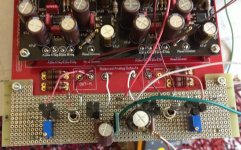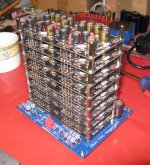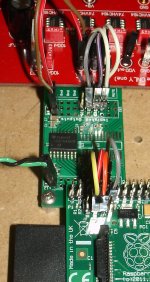Possible loss of firmware? I have seen this on other dacs. I think it tells you how to get into the receiver control panel on Doede's or Luckit's site. Good luck!
Meaning a new deck PCB revision Doede?
haha, no no, first bread board testing.... IF, than no new boards till end of the year....
If I'm correct the (Tent) clock is only used for the spdif part?
indeed....
I'm totally baffled, sat down to listen to my hifi and my MacBook Pro decides it can't see my DDDAC.
I have tried all the usual re boot advice etc but it's a no go. Any Ideas?
exclude other errors first, check power, self powered versus USB power, power sequence, USB cable, try another computers etc.
all fails, upload the firmware again,malls fails? send back the unit for repair....
DDDAC JFET B1 Buffer: I built the buffer which I explained in post #936 in this forum. http://www.diyaudio.com/forums/digi...-pcm1794-waveio-usb-input-94.html#post3786577
There have been many comments that a single board DDDAC cannot properly drive a transformer output - and I agree. The Cinemag sounded very nice and polite with my single board DDDAC. The bass was a bit recessed. I wanted more from the DAC. I also wanted to upgrade the various voltage sources which others said made a noticeable improvement, but I didn't want to do all this for several boards.
I used parallel 2SK170s for each of the balanced output channels running at about 11-12ma each. The bottom pairs of JFETs act as a constant current load for the upper JFETs. The DDDAC sees a load >1meg ohm at the input to the JFETs, but the transformers are driven by the buffer output. The 20ohm pots in the constant current load are used to adjust the balanced outputs offset to near 0.0mv.
If the improvement in musical richness, detail, and liveliness I hear now is anything like what is reported with 4 or 8 boards, I can understand the excitement from stacking DAC boards. The bass is now tightly defined and more prominent. The buffer components are still breaking in but I intend to share the circuit details if this buffer sounds great after 300 hours of play time.
The switches on the picture of the board I built were for bypassing the buffer to test the difference. Time to remove the switches - no contest and no going back.
The BF862 is an inexpensive surface mount JFET in current production that reportedly sounds even better than the legendary obsolete 2SK170 and puts out about twice the current. I plan to try this next. I may be getting ahead of myself, but the BF862 and Susumu RG SMD resistors would fit on the main board.
There have been many comments that a single board DDDAC cannot properly drive a transformer output - and I agree. The Cinemag sounded very nice and polite with my single board DDDAC. The bass was a bit recessed. I wanted more from the DAC. I also wanted to upgrade the various voltage sources which others said made a noticeable improvement, but I didn't want to do all this for several boards.
I used parallel 2SK170s for each of the balanced output channels running at about 11-12ma each. The bottom pairs of JFETs act as a constant current load for the upper JFETs. The DDDAC sees a load >1meg ohm at the input to the JFETs, but the transformers are driven by the buffer output. The 20ohm pots in the constant current load are used to adjust the balanced outputs offset to near 0.0mv.
If the improvement in musical richness, detail, and liveliness I hear now is anything like what is reported with 4 or 8 boards, I can understand the excitement from stacking DAC boards. The bass is now tightly defined and more prominent. The buffer components are still breaking in but I intend to share the circuit details if this buffer sounds great after 300 hours of play time.
The switches on the picture of the board I built were for bypassing the buffer to test the difference. Time to remove the switches - no contest and no going back.
The BF862 is an inexpensive surface mount JFET in current production that reportedly sounds even better than the legendary obsolete 2SK170 and puts out about twice the current. I plan to try this next. I may be getting ahead of myself, but the BF862 and Susumu RG SMD resistors would fit on the main board.
Attachments
Last edited:
Hi Doede,exclude other errors first, check power, self powered versus USB power, power sequence, USB cable, try another computers etc.
all fails, upload the firmware again,malls fails? send back the unit for repair....
I have tried my Wife's MAcBook and another USB cable without success, all lights on the DAC and USB board.
As I am using MAC laptops surely I don't need to upload firmware (or maybe I do) I didn't have to upload anything to enable the laptop to see the DAC first time round.
Hi Doede,
I have tried my Wife's MAcBook and another USB cable without success, all lights on the DAC and USB board.
As I am using MAC laptops surely I don't need to upload firmware (or maybe I do) I didn't have to upload anything to enable the laptop to see the DAC first time round.
you mix up driver software and firmware. also firmware is needed. as described before, it did happen occasionally that firmware got corrupted.
Lucian site describes how to do this.
if you have no means for this or not sure, just send the board to me please. I will take care of the rest
you mix up driver software and firmware. also firmware is needed. as described before, it did happen occasionally that firmware got corrupted.
Lucian site describes how to do this.
if you have no means for this or not sure, just send the board to me please. I will take care of the rest
Thanks again for the advice!!! 🙂
Could you publish the circuit schematic please, I'm interested in the jfets driving the balanced outputs directly to my amp.DDDAC JFET B1 Buffer: I built the buffer which I explained in post #936 in this forum. http://www.diyaudio.com/forums/digi...-pcm1794-waveio-usb-input-94.html#post3786577
There have been many comments that a single board DDDAC cannot properly drive a transformer output - and I agree. The Cinemag sounded very nice and polite with my single board DDDAC. The bass was a bit recessed. I wanted more from the DAC. I also wanted to upgrade the various voltage sources which others said made a noticeable improvement, but I didn't want to do all this for several boards.
I used parallel 2SK170s for each of the balanced output channels running at about 11-12ma each. The bottom pairs of JFETs act as a constant current load for the upper JFETs. The DDDAC sees a load >1meg ohm at the input to the JFETs, but the transformers are driven by the buffer output. The 20ohm pots in the constant current load are used to adjust the balanced outputs offset to near 0.0mv.
If the improvement in musical richness, detail, and liveliness I hear now is anything like what is reported with 4 or 8 boards, I can understand the excitement from stacking DAC boards. The bass is now tightly defined and more prominent. The buffer components are still breaking in but I intend to share the circuit details if this buffer sounds great after 300 hours of play time.
The switches on the picture of the board I built were for bypassing the buffer to test the difference. Time to remove the switches - no contest and no going back.
The BF862 is an inexpensive surface mount JFET in current production that reportedly sounds even better than the legendary obsolete 2SK170 and puts out about twice the current. I plan to try this next. I may be getting ahead of myself, but the BF862 and Susumu RG SMD resistors would fit on the main board.
I have searched the internet high and low for the relevant Mac firmware and all I can see is for Windows. Does anyone on this thread use an Apple Mac that is able to help?
Thanks
Thanks
I have searched the internet high and low for the relevant Mac firmware and all I can see is for Windows. Does anyone on this thread use an Apple Mac that is able to help?
Thanks
Like Doede tried to explain; it's not the driver software, Mac OS an linux have the drivers on board.
It's the firmware, that is the software that is loaded on the Wave IO. You canfind it at the luckit.biz website.
hi,
has anyone else tried Palmitos approach and feeding the DAC with I2S coming from an raspberryPi? I am highly interested in this because if you look (hear) at the sound quality you can get from a very simple DAC like the Hifiberry I am wondering what would be possible with a "state of the art" DAC.
has anyone else tried Palmitos approach and feeding the DAC with I2S coming from an raspberryPi? I am highly interested in this because if you look (hear) at the sound quality you can get from a very simple DAC like the Hifiberry I am wondering what would be possible with a "state of the art" DAC.
I had not commented on the sound because I'm currently playing with using the LL1684 transformers for output. The i2s rpi input in my ears sounds better, more dynamic & more detailed, than the waveio. I like the waveio better than the amanero for i2s, so this implies that the rpi also sounds better than the amanero, but I have not actually compared them. I removed the waveio permanently and have been testing other things (isolator and transformer output) with the rpi. I think it will stay there until a better embedded platform offers i2s support (udoo, beaglebone black, cubietruck, etc.).
I tried using the diyinhk amanero isolator between the rpi and the dac but thought it cut on the dynamics and detail some. But I made the mistake of powering the rpi side of the isolator with the rpi 3.3v supply. I will hook it up again later powering the rpi side with an independent 3.3v supply, using only the i2s lines from rpi into the isolator. Even though the isolator cut on the dynamics and the detail, it did make the background very quiet when compared to the direct i2s to the dac.
I tried using the diyinhk amanero isolator between the rpi and the dac but thought it cut on the dynamics and detail some. But I made the mistake of powering the rpi side of the isolator with the rpi 3.3v supply. I will hook it up again later powering the rpi side with an independent 3.3v supply, using only the i2s lines from rpi into the isolator. Even though the isolator cut on the dynamics and the detail, it did make the background very quiet when compared to the direct i2s to the dac.
Thanks for the quick reply.
I am highly interested in this I2S issue. it could turn into a real nice and comfortable solution. Or it already has 🙂
I now start with some "cheap" ESS9023 DAC and will try to make my way up in Soundquality.
I am a fairly new and addicted music lover. 🙂
I am highly interested in this I2S issue. it could turn into a real nice and comfortable solution. Or it already has 🙂
I now start with some "cheap" ESS9023 DAC and will try to make my way up in Soundquality.
I am a fairly new and addicted music lover. 🙂
Hi,
I have been trying the pi I2S output last weekend and I am not impressed yet.
I used a cheap samsung switching power supply so I expect that contributes to the bad sound.
You can hear rough highs that are probably created by; power supply, jitter and digital noise on the pi ground.
I would also expect that the wave io is better due to the nice clocks, asynchronous streaming and ground isolation.
I do not want to jump to conclusions because I believe that dispite all theory one can only judge by listening to the differences.
I will try it with a nice linear shunt supply later.
I have been trying the pi I2S output last weekend and I am not impressed yet.
I used a cheap samsung switching power supply so I expect that contributes to the bad sound.
You can hear rough highs that are probably created by; power supply, jitter and digital noise on the pi ground.
I would also expect that the wave io is better due to the nice clocks, asynchronous streaming and ground isolation.
I do not want to jump to conclusions because I believe that dispite all theory one can only judge by listening to the differences.
I will try it with a nice linear shunt supply later.
I would also expect that the wave io is better due to the nice clocks, asynchronous streaming and ground isolation.
The waveio clocks are much better than the rpi's, no question on that. An isolator board will help with the ground sharing problem I think?
When I first hooked it up with the cap output it did sound harsh compared to the waveio, but even then the dynamics and detail were better to my ears in my system. Adding the LL1684 instead of the caps took care of a lot of the harshness.
Last night I added the diyinhk amanero isolator but this time powered it from the 3.3v external power supply instead of the rpi's 3.3v pin. It does sound cleaner and regained some of the lost dynamics and detail. I'm leaving it like this for now. Maybe a better isolator and a reclocker would help (like an Acko board or Ian's FIFO or maybe just changing the TI chip for an NVE IL715E in the diyinhk isolator). I will try later and see.
Attachments
The waveio clocks are much better than the rpi's, no question on that. Maybe a better isolator and a reclocker would help (like an Acko board or Ian's FIFO or maybe just changing the TI chip for an NVE IL715E in the diyinhk isolator). I will try later and see.
I am running the pi with an isolator and a reclocker and it sounds fantastic! This setup is called Wave IO 😀
But seriously: I would expect a good isolator would help. Wouldn't it also be possible to put an accurate clock on the Pi?
But the waveio is a usb receiver that has to process the usb stream into i2s. The rpi is bypassing that and giving you straight i2s, unless there's something I'm not getting. Otherwise there would be no purpose in using the rpi with i2s.I am running the pi with an isolator and a reclocker and it sounds fantastic! This setup is called Wave IO 😀
I'll try hooking up the rpi to Ian's fifo see how it sounds. But with just the isolator it sounds good for me, others mileage may vary...
Hi Palmito,
The pcm stream will be converted in the pi to I2S when used without wave io, with wave io it is converted from pcm to usb and than in the wave io into i2s. So conversion will take place in any case, it's a matter of choosing the best conversion appliance.
I do not know the difference between pcm and usb and how intensive the conversion will be. Need to study on this.
But apart from the technical background, the goal is to use the best sounding principle, this may vary a bit due to the audio system used and personal preferences.
In any case, Volumio on the pi sounds quite amazing in comparison to PC. The advantages are obvious: you can use a nice quiet power supply, there are no unused background processes running that interfere with the audio stream, the kernel and os can be optimized for audio, ramplay is possible...... And full controll from your listening seat with mPad on iPad!
And on top of all this: I prefer to spend my money on good tubes instead of a piece of software 😀
I am no programmer but I hope the Volumio guys will continue to improve the software for us dumb users 🙄
The pcm stream will be converted in the pi to I2S when used without wave io, with wave io it is converted from pcm to usb and than in the wave io into i2s. So conversion will take place in any case, it's a matter of choosing the best conversion appliance.
I do not know the difference between pcm and usb and how intensive the conversion will be. Need to study on this.
But apart from the technical background, the goal is to use the best sounding principle, this may vary a bit due to the audio system used and personal preferences.
In any case, Volumio on the pi sounds quite amazing in comparison to PC. The advantages are obvious: you can use a nice quiet power supply, there are no unused background processes running that interfere with the audio stream, the kernel and os can be optimized for audio, ramplay is possible...... And full controll from your listening seat with mPad on iPad!
And on top of all this: I prefer to spend my money on good tubes instead of a piece of software 😀
I am no programmer but I hope the Volumio guys will continue to improve the software for us dumb users 🙄
- Home
- Source & Line
- Digital Line Level
- A NOS 192/24 DAC with the PCM1794 (and WaveIO USB input)


